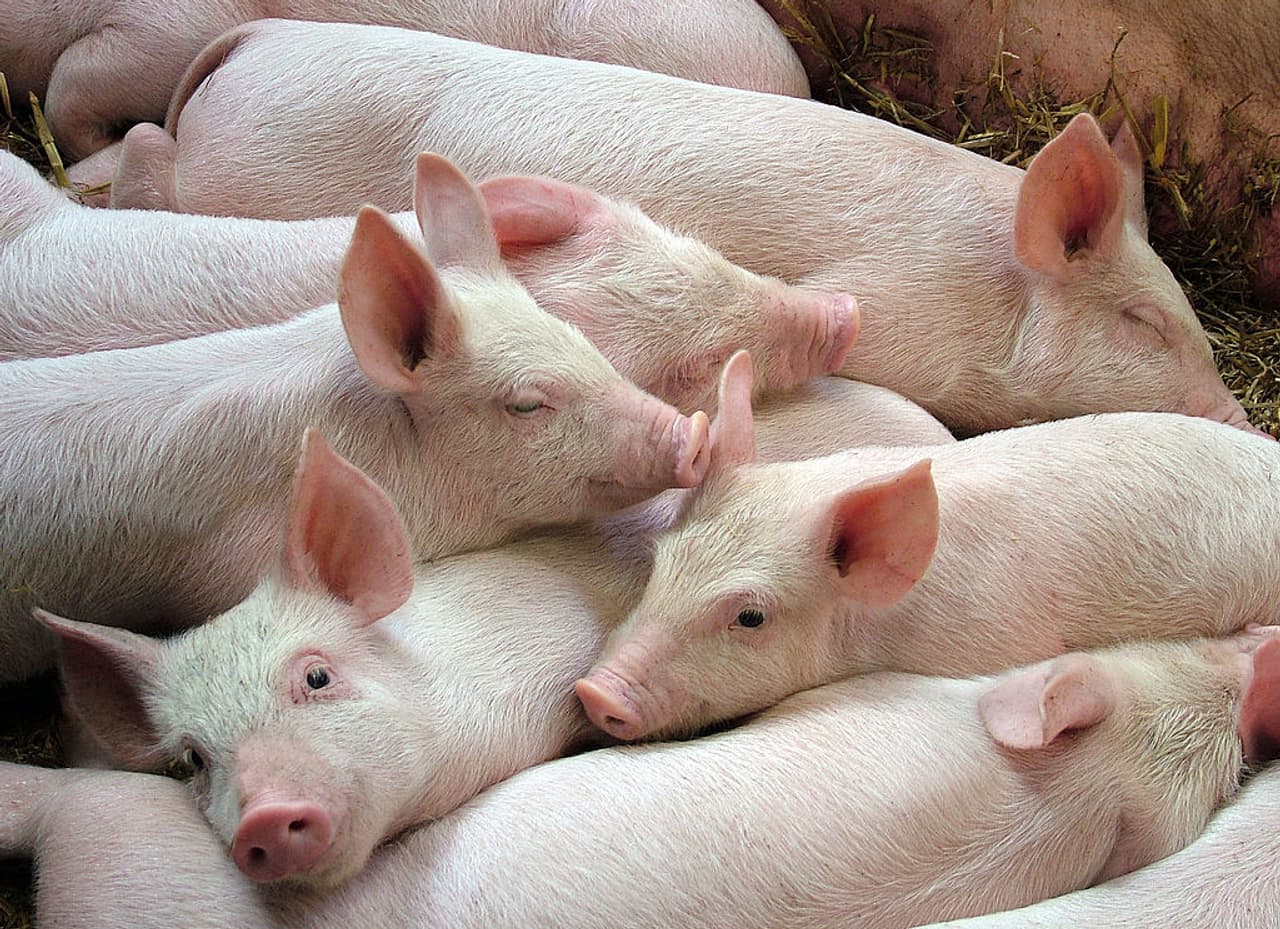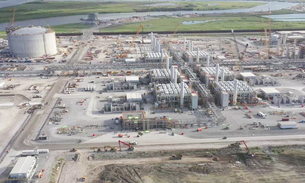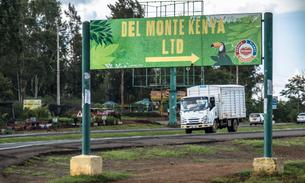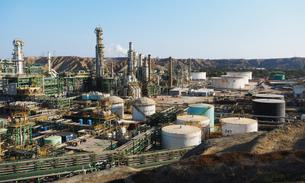The rise of the "megafarm": How British meat is made
In Herefordshire the river Wye curls through market towns, forests of oak and yellow fields tall with rapeseed. It is an area of outstanding natural beauty - walkers come to the area to traverse Offa’s Dyke, go fishing or catch a glimpse of herons, bats or polecats. Which makes the sight just down the road from the church in one small village somewhat unexpected.
A short walk along a public footpath a few miles from the river brings you to a field where large white polyethene tunnels stretch dozens of metres down a hill. They are met at the bottom by five mammoth sheds - each as long as a football pitch. Tall metal silos rise up from between the imposing units.
It looks like something out of a sci-fi film - but it is in fact a typical modern UK farm. Inside the warehouse walls, nearly 800,000 chickens are being bred for slaughter at any one time.
This facility is one of nearly 1,700 intensive poultry and pig farms licensed by the Environment Agency. A Bureau investigation shows that the number of such farms in the UK has increased by a quarter in the last six years.
Many of these units like the one in Herefordshire are giant US-style “megafarms”. Our investigation has discovered there now nearly 800 of these throughout the UK. The biggest house more than a million chickens, 20,000 pigs or 2,000 dairy cows, in sprawling factory units where most animals are confined indoors.
The growth in intensive farms is concentrated in certain parts of the country where major food companies operate and many are in the process of expanding. In Herefordshire, intensively-farmed animals outnumber the human population by 88 to one.
The two biggest farms we have recorded have the capacity to house 1.7 million and 1.4 million chickens apiece.
Behind the data lies a fundamental debate about what we want to eat as a nation, and what price we are prepared to pay for that food.
The big farms say they are led by consumers - people want to buy cheap meat, and intensive farming is the only way to efficiently satisfy that demand. But critics say factory farms blight local communities, subject animals to prolonged distress and push out small producers - and that we do not need the vast quantities of meat we consume.
Norman Lamb, the MP for Norfolk, called on the government to review whether the regulations around intensive units were robust.
“The government need to gain a greater understanding of the impact of these very large units,” he said. “They should look at whether lessons can be learned from the US. We need new and robust domestic regulations to meet the emerging landscape and to take the place of European Union legislation post-Brexit.”
The majority of Britain’s poultry meat is produced by a handful of large companies including Faccenda, Moy Park, Cargill, 2 Sisters and Banham Poultry - all of which are privately-owned. Tesco, Sainsbury’s, Morrisons, Asda, McDonalds, and Nando’s are among the supermarkets and fast food chains who source meat from companies operating megafarms, our investigation has found.
High demand for low-cost meat
The rise in intensive farming has been fuelled by Britain’s demand for cheap meat, especially chicken. Close to a billion birds are slaughtered each year, almost all of them intensively-farmed. The majority of the UK’s megafarms are poultry units.
Growing free-range and organic chickens requires a lot of space - about four square metres per animal for organic birds. Intensive farms typically have about 15 chickens per square metre, or an area about the size of an A4 sheet of paper for each bird.
Intensive farming also allows farms to carefully control the temperature and humidity of chicken units, and give just the right amount of additive-boosted feed and chlorinated water for optimal growth in a short time. The lifespan of an average intensively-farmed chicken is 35 days.
The efficiency of the system is illustrated in the product prices. A review of five major supermarket chickens shows basic, value or own brand chicken – raised on intensive farms - costs between £1.99 and £2.73 per kg for a whole roasting bird. Organic chicken – i.e. birds kept in a smaller flock, given access to the outdoors, and fed on additive and GM-free grain grown on that farm - costs between £6.00 and £7.04 per kg per roasting bird.
While demand for free range eggs has risen substantially in the last two decades, free range and organic chicken still only accounts for a tiny proportion of the market - just 3% and 1% respectively.
Some farms producing free-range poultry products - mainly eggs - are actually large enough that they are classified as intensive. But the Bureau has calculated at least three quarters of intensive poultry farms are factory-style units with some or all birds permanently housed indoors - and the figure could be higher as not all records have been made available.
Intensive farms from the skies
The Bureau sent a drone to capture footage of Britain's big farms from above. Watch the video below.
Advanced technology
Currently there has been little demand to stop the growth of intensive farms and move to organic farming, said Richard Griffiths, chief executive of the British Poultry Council. He said organic farms would take up much more space “If we tried to grow a billion birds a year, that would be a lot of land It’s a balancing act and it’s demand driven.”
Intensive farms maintain high environmental, hygiene and welfare standards when they are run properly these are high health and welfare farms,” he argued. "The husbandry of the birds is the crucial element here. I think people think of hens roaming around a farm but that image is no longer the case – that’s not how chicken is farmed any more.”
Dr Zoë Davies, chief executive of the National Pig Association (NPA), the industry body for pig farmers, said farmers had to operate intensive systems to compete with cheap European imports.
Intensive farms have to meet many different regulations to get an Environment Agency permit, she said, and the biggest farms have excellent resources to maintain welfare standards, such as specialist vets on site.
She reiterated that there was a lack of consumer demand for free-range meat.
“People like the idea of a family farm,” she said. “They don’t know what an actual farm looks like."
A spokesperson for major poultry company Faccenda said the scale of big farms allowed them to afford to invest in green technologies.
“On large modern farms it’s easier to create and maintain the right environment, meaning that our animals are raised somewhere that is warm, dry and clean, and the risk of air borne diseases, such as avian influenza, is greatly reduced,” she said.
“Through investing in fewer, larger facilities we make the best use of scarce agricultural land and reduce the environmental impact of our farms. We have for example biomass energy on all of our farms.”
Inside a poultry megafarm
Richard Williams invited the Bureau to Penhros Farm near the picturesque village of Kington, Herefordshire, where he has four sheds each housing 42,000 chickens. From this farm he produces nearly 1.3 million chickens a year for the giant food company Cargill, which supplies Tesco.
Inside, the sweet sickly odour is overpowering. You can’t see the floor for chickens. The sheds have some hay bales and wooden perches.
“They’ve got enrichment,” Williams says. “Windows so they get daylight and fresh air… Is this cruel? I don’t think so”.
The chickens are bred to grow quickly, provide a good yield of meat, eat little feed and be disease-resistant. They are trucked in as chicks. Each batch of chickens is called a “crop” and he has about eight crops a year, cleaning the sheds in between each one.
The farm is slick - a computer-controlled environment optimized to produce safe, cheap meat. The birds are fed on pellets provided by Cargill, which contain soya, minerals and additives, mixed with locally grown wheat. They drink chlorinated water.
Williams says he hasn’t used a single antibiotic since the site was set up two years ago. Instead, he uses a product which changes the birds’ gut flora. “it’s like Yakult, lets the good bacteria grow and stops the bad bacteria growing.”
The farm is environmentally friendly, says Williams. The sheds are heated by a biomass boiler fueled by recycled timber waste. The hatchery, feed mill, and factory, all owned by Cargill, are within 15 miles. “Tell me that isn’t a good carbon footprint.”
Responding to complaints from neighbours, Williams says the farm keeps local people in work, like the truck drivers who deliver chicks, feed and shavings. His customer, Cargill, is one of the biggest employers in Herefordshire.
Ultimately he thinks this is the most efficient way to produce protein – and that the market shows consumers in their droves choose it over organic meat. “This is producing safe, cheap, available protein,” he says. “Is it any more complicated than that?"
An inhumane industry?
The critics paint a different picture, saying cheap meat comes at a cost for society at large. Intensively-farmed animals suffer more disease and other health problems, they say, also pointing to the stress created by early weaning and confinement, which can lead to animals starting to injure and cannibalise each other.
The campaign group Compassion in World Farming (CIWF) believes intensive farming is inhumane, and cannot be justified by efficiency arguments. It has launched a campaign highlighting what it calls the UK's factory farming hotspots. According to CIWF there are nearly 17 million factory farmed animals in Herefordshire, 15 million in Shropshire and 12 million in Norfolk.
“Bringing animals off the land and cramming them into factory farms is not only cruel to animals but also has far reaching effects on human health, wildlife and the planet,” said the organisation’s campaigns director Emma Slawinski who said it sounded like "a space-saving idea but this ignores the fact that vast amounts of land are used elsewhere to grow food for them – often in huge crop fields doused in chemical pesticides and fertilisers – squeezing wildlife out, as industrial farming methods sweep the planet.”
Make change possible
Investigative journalism is vital for democracy. Help us to expose injustice and spark change
Click here to support usFarms can be breeding grounds for food poisoning bugs such as campylobacter, E.coli and salmonella. In intensive farms the close proximity of the animals can mean diseases spread quickly. This has historically meant the widespread use of antibiotics, the use of such drugs by poultry farmers had dropped significantly in recent years.
Industrial-scale farming also produces huge amounts of manure, carcasses, silage and dirty water, all of which can have significant environmental impacts even when disposed of properly. People living in the shadows of megafarms complain of lorries clogging up local roads as they transport grain and waste, and picturesque rural areas being spoiled by foul smells and ugly buildings.
The Bureau’s findings regarding the growth of intensive farms highlighted a “hugely worrying trend”, said Zac Goldsmith, MP for Richmond.
“American-style agribusiness comes with serious environmental and animal welfare implications, as well as posing a threat to our small and family farmers,” said Goldsmith, who previously described plans for a US-style mega-dairy in Lincolnshire as “squalid”.
“Even more importantly, the continued overuse of antibiotics on intensive farms is contributing to widespread antibiotic resistance and consequently the biggest human health threat we face."
Conflict in the countryside
The growth of intensive farms has caused conflict in the countryside. The Bureau asked the owner of Penhros Farm in Herefordshire, Richard Williams, and his neighbour Janet Srodzinski, to share their views.
"It’s a horrible sweet sickly smell... I pray for north winds now"
Janet Srodzinski lives 235 metres from four chicken sheds near the village of Kington, Herefordshire
The first lot of chickens came August 2015. It’s made my life very difficult. My life is my garden and my dogs. I’ve got quite a big garden and I used to love sitting in it. Now if the wind is in the wrong direction for me, I can’t go outside because of the smell. It’s a horrible sweet sickly smell. It’s a mix of bedding, chicken droppings, goodness only knows what. Its weekends as well. I remember Christmas Day, 2015 - I went out on to my terrace and I was almost sick. The smell was dreadful all day, Christmas day. Last summer was a bit better because we had north-westerly winds. I pray for north winds now.
Then there’s the lorries. They grind up the hill. It’s so congested. They didn’t consider the impacts on the local infrastructure at all. The lorries come at night. Once it was 4 o'clock one morning and it lit the bedroom up and woke me up. I’ve moved bedrooms now, I don’t sleep there anymore because I’ll be woken up by the lorries. Its 26 lorries going in and out, 56 movements. Coming every 35 days.
It’s a lovely county and these sheds have ruined it. My next door neighbour did a charity cycle run and everywhere they went there was a smell of chickens. For a tourist area, it’s just not very nice. In my opinion if we’ve got to have chicken sheds it’s got to be as far away from humans as possible.
"We’re making safe, quality protein grown in the UK"
Richard Williams owns the broiler sheds, growing about 1.3 million birds a year for major poultry company Cargill
I’ve lived in the area all my life. My father bought a 60 acre farm in 1960. I just want everyone to get along. I think there’s a difference between what people who come to the countryside to retire feel about the land and people who are making a living on it. We can have huge areas completely protected and have them as monuments. But is that going to feed the nation?
I worked with the planning officer and decided this was the best place for the site. The chickens are quiet. We’re here on a hot day with the wind blowing in our face and there’s no odour. I’ve planted orchards in the hill in front of it – and trees directly in front of it. I also painted the sheds, the feed bins and the plumes juniper green to make them blend in - even though that was more expensive.
Mrs Srodinzki complains about the lorries but the A44 is a busy trunk road. There’s a quarry nearby and a sewage farm. The feed trucks for this farm – its 12 trailer loads every 47 days. It wasn’t in planning rules but I asked for a one way system to help traffic and I asked for the feed trucks to come in the day. Catching the birds [to take them to slaughter] - yes the trucks come at night and it can be all night - but that’s because its calmer for the birds. It’s for animal welfare.
Poultry is one of the biggest success stories of farming – it isn’t subsidised. It stands on its own two feet. Cargill is a major employer in the area. We employ three people and 40 different companies during each crop. Remember, I’m doing this to provide for my children. I’m not wealthy by any stretch and I’ve got a lot of borrowed money. This gives us an opportunity to make profit. Everything we do is driven by the consumer. We’re making safe, quality protein grown in the UK.
Small-scale producers pushed out
As intensive farms have spread, small farms have closed down. About 4,000 farms closed between 2010 and 2016, according to the Department of Environment and Rural Affairs, of which three quarters were in the smallest category (less than 20 hectares of land). The number of big farms – those with more than 100 hectares – remained constant.
Pippa Woods, of the Family Farmers’ Association, said the increased price of land combined with falling prices for goods meant family farmers could not compete with larger farms, who can make far more profit thanks to the economy of scale.
She used to keep a thousand hens and earned enough money from the eggs to pay her weekly food bill. But the growth of battery eggs led to the price of eggs dropping, and her hens became unprofitable.
With profit margins on smaller farms wafer thin, some feel they should expand and start supplying big, integrated companies to secure their future, she said.
The loss of small farmers would be a great loss for the UK, she warned, as they are good custodians of the countryside. They tend to run mixed farms, which helps keep soil healthy and produces grain for the animals, whereas intensive farms bring in grain and dispose of waste on HGVs going in and out. Pollution accidents from large intensive farms are on a bigger scale and much more disastrous, she added.
“Local farmers contribute to the economy, the local area, the local communities,” said Woods.

Farming at a critical crossroads
Professor Charles Godfray, a food policy expert from Oxford University said it was not as simple as saying intensive farms were bad and small ones were good.
"It’s much more about how you do it,” he said. “There are intensive operations which are horrible, and others which are good examples of how to look after animals well and get good outcomes.
“You have the most excellent free range examples and other poorly-managed and poorly-led operations.”
The Bureau asked the Department for Environment, Food and Rural Affairs to comment on the rise of intensive farming in the UK and how the future might look, but it did not respond to our findings.
It did say the government would “not compromise on our high animal welfare or environmental standards,” and it would “always protect our proud and varied farming traditions.”
Leaving the EU offered “an unprecedented opportunity to shape our farming industry so it works for the UK,” said Defra.
Dan Crossley of the thinktank Food Ethics Council thinks that Brexit leaves us at a critical juncture. "Will our government seek free trade deals at any cost, lowering standards and ramping up intensive farming? Or will the UK push for a ‘race to the top’ on animal welfare standards, environmental protection and workers’ rights?"
The UK has to do some “hard thinking” about how we want our food to be produced, said Lamb, the Norfolk MP.
“It’s easy to condemn the producers but the vast majority of people eat meat," he said. “‘We need to have a national debate about whether we can justify the methods to deliver cheap food. I can choose between organic meat and cheap meat. But people on low incomes might struggle to make that choice within their weekly budgets.”
Additional reporting by David Child
All photos of Penhros intensive chicken farm by Rob Stothard



